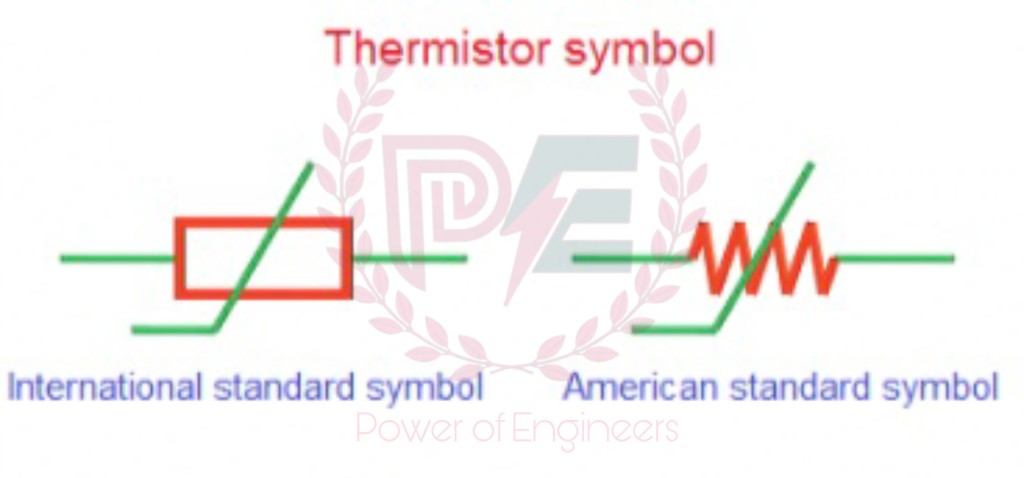Thermistor: Definition, Uses & How They Work
What is a Thermistor?
A thermistor (or thermal resistor) is defined as a type of resistor whose electrical resistance varies with changes in temperature. Although all resistors’ resistance will fluctuate slightly with temperature, a thermistor is particularly sensitive to temperature changes.
Thermistors act as a passive component in a circuit. They are an accurate, cheap, and robust way to measure temperature. While they do not work well in extremely hot or cold temperatures, they are the sensor of choice for many different applications. They are ideal when a precise temperature reading is required. The circuit symbol for a thermistor is shown below:

Uses of Thermistors
Thermistors have a variety of applications. They are widely used as a way to measure temperature as a thermistor thermometer in many different liquid and ambient air environments. Some of the most common uses of thermistors include:
- Digital thermometers (thermostats)
- Automotive applications (to measure oil and coolant temperatures in cars & trucks)
- Household appliances (like microwaves, fridges, and ovens)
- Circuit protection (i.e. surge protection)
- Rechargeable batteries (ensure the correct battery temperature is maintained)
- To measure the thermal conductivity of electrical materials
- Useful in many basic electronic circuits (e.g. as part of a beginner Arduino starter kit)
- Temperature compensation (i.e. maintain resistance to compensate for effects caused by changes in temperature in another part of the circuit)
- Used in wheatstone bridge circuits
How Does a Thermistor Work
The working principle of a thermistor is that its resistance is dependent on its temperature. We can measure the resistance of a thermistor using an ohmmeter. If we know the exact relationship between how changes in the temperature will affect the resistance of the thermistor – then by measuring the thermistor’s resistance we can derive its temperature.
How much the resistance changes depends on the type of material used in the thermistor. The relationship between a thermistor’s temperature and resistance is non-linear. A typical thermistor graph is shown below:

If we had a thermistor with the above temperature graph, we could simply line up the resistance measured by the ohmmeter with the temperature indicated on the graph. By drawing a horizontal line across from the resistance on the y-axis, and drawing a vertical line down from where this horizontal line intersects with the graph, we can hence derive the temperature of the thermistor.
Thermistor Types
There are two types of thermistors:
- Negative Temperature Coefficient (NTC) Thermistor
- Positive Temperature Coefficient (PTC) Thermistor
NTC Thermistor
In an NTC thermistor, when the temperature increases, resistance decreases. And when temperature decreases, resistance increases. Hence in an NTC thermistor temperature and resistance are inversely proportional. These are the most common type of themistor.
The relationship between resistance and temperature in an NTC thermistor is governed by the following expression:

Where:
- RT is the resistance at temperature T (K)
- R0 is the resistance at temperature T0 (K)
- T0 is the reference temperature (normally 25oC)
- β is a constant, its value is dependant on the characteristics of the material. The nominal value is taken as 4000.
If the value of β is high, then the resistor–temperature relationship will be very good. A higher value of β means a higher variation in resistance for the same rise in temperature – hence you have increased the sensitivity (and hence accuracy) of the thermistor.
From the expression (1), we can obtain the resistance temperature co-efficient. This is nothing but the expression for the sensitivity of the thermistor.

Above we can clearly see that the αT has a negative sign. This negative sign indicates the negative resistance-temperature characteristics of the NTC thermistor.
If β = 4000 K and T = 298 K, then the αT = –0.0045/oK. This is much higher than the sensitivity of platinum RTD. This would be able to measure the very small changes in the temperature.
However, alternative forms of heavily doped thermistors are now available (at high cost) that have a positive temperature co-efficient. The expression (1) is such that it is not possible to make a linear approximation to the curve over even a small temperature range, and hence the thermistors is very definitely a non-linear sensor.
PTC Thermistor
A PTC thermistor has the reverse relationship between temperature and resistance. When temperature increases, the resistance increases. And when temperature decreases, resistance decreases. Hence in a PTC thermistor temperature and resistance are inversely proportional.

Although PTC thermistors are not as common as NTC thermistors, they are frequently used as a form of circuit protection. Similar to the function of fuses, PTC thermistors can act as current-limiting device.
When current passes through a device it will cause a small amount of resistive heating. If the current is large enough to generate more heat than the device can lose to its surroundings then the device heats up. In a PTC thermistor, this heating up will also cause its resistance will increase. This creates a self-reinforcing effect that drives the resistance upwards, therefore limiting the current. In this way, it acts as a current limiting device – protecting the circuit.
Thermistor Characteristics
The relationship governing the characteristics of a thermistor is given below as:

Where:
- R1 = resistance of the thermistor at absolute temperature T1[oK]
- R2 = resistance of the thermistor at temperature T2 [oK]
- β = constant depending upon the material of the transducer
We can see in the equation above that the relationship between temperature and resistance is highly nonlinear. A standard NTC thermistor usually exhibits a negative thermal resistance temperature coefficient of about 0.05/oC.
Thermistor Construction
To make a thermistor, two or more semiconductor powders made of metallic oxides are mixed with a binder to form a slurry. Small drops of this slurry are formed over the lead wires. For drying purpose, we have to put it into a sintering furnace. During this process, that slurry will shrink onto the lead wires to make an electrical connection. This processed metallic oxide is sealed by putting a glass coating on it. This glass coating gives a waterproof property to the thermistors – helping to improve their stability.

There are different shapes and sizes of thermistors available in the market. Smaller thermistors are in the form of beads of diameter from 0.15 millimeters to 1.5 millimeters. Thermistors may also be in the form of disks and washers made by pressing the thermistor material under high pressure into flat cylindrical shapes with diameter from 3 millimeters to 25 millimeters.

The typical size of a thermistor is 0.125mm to 1.5 mm. Commercially available thermistors have nominal values of 1K, 2K, 10K, 20K, 100K, etc. This value indicates the resistance value at a temperature of 25oC.
Thermistors are available in different models: bead type, rod type, disc type, etc. The major advantages of thermistors are their small size and relatively low cost.
This size advantage means that the time constant of thermistors operated in sheaths is small, although the size reduction also decreases its heat dissipation capability and so makes the self-heating effect greater. This effect can permanently damage the thermistor.
To prevent this, thermistors have to be operated at low levels of electric current compared to resistance thermometer – resulting in lower measurement sensitivity.
Thermistor vs Thermocouple
The main differences between a thermistor and a thermocouple are:
Thermistors:
- A more narrow range of sensing (55 to +150oC – although this varies depending on the brand)
- Sensing parameter = Resistance
- Nonlinear relationship between the sensing parameter (resistance) and temperature
- NTC thermistors have a roughly exponential decrease in resistance with increasing temperature
- Good for sensing small changes in temperature (it’s hard to use a thermistor accurately and with high resolution over more than a 50oC range).
- The sensing circuit is simple and doesn’t need amplification & is very simple
- Accuracy is usually hard to get better than 1oC without calibration
Thermocouples:
- Have a wide range of temperature sensing (Type T = -200-350oC; Type J = 95-760°C; Type K = 95-1260°C; other types go to even higher temperatures)
- Can be very accurate
- Sensing parameter = voltage generated by junctions at different temperatures
- Thermocouple voltage is relatively low
- Linear relationship between the sensing parameter (voltage) and temperature
Thermistor vs RTD
Resistance Temperature Detectors (also known as RTD sensors) are very similar to thermistors. Both RTDs and thermistors have varying resistance dependent on the temperature.
The main difference between the two is the type of material that they are made of. Thermistors are commonly made with ceramic or polymer materials while RTDs are made of pure metals. In terms of performance, thermistors win in almost all aspects.
Thermistors are more accurate, cheaper, and have faster response times than RTDs. The only real disadvantage of a thermistor vs an RTD is when it comes to temperature range. RTDs can measure temperature over a wider range than a thermistor.
Aside from this, there is no reason to use a thermistor over an RTD.


You must be logged in to post a comment.